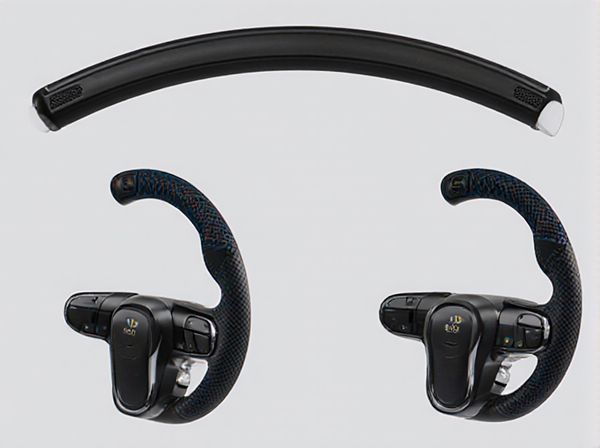
Photo illustration: Tilt Steering vs Telescopic Steering
Tilt steering allows you to adjust the steering wheel's angle up or down for a comfortable driving position, while telescopic steering lets you change the wheel's distance by moving it closer or farther away. Both features enhance driving ergonomics, but telescopic steering offers greater control over reach, especially for drivers with varying arm lengths. Choosing between tilt and telescopic steering depends on your personal comfort and driving style preferences.
Table of Comparison
| Feature | Tilt Steering | Telescopic Steering |
|---|---|---|
| Adjustment Type | Angular adjustment of steering wheel up or down | Forward and backward extension or retraction of steering wheel |
| Driver Comfort | Improves vertical reach, better for height variations | Enhances horizontal reach, suits arm length variations |
| Usage | Common in most modern vehicles for ergonomic positioning | Typically paired with tilt steering for full adjustability |
| Installation Complexity | Simple mechanism, fewer moving parts | More complex mechanism, requires robust sliding joints |
| Cost | Generally lower cost | Higher cost due to advanced design |
| Safety Consideration | Minimal impact on airbag alignment | Requires precise alignment to maintain airbag effectiveness |
Introduction to Steering Column Adjustments
Steering column adjustments enhance driver comfort and control by allowing customization of the steering wheel position. Tilt steering enables vertical movement, adjusting the wheel angle up or down, while telescopic steering allows the wheel to move closer or farther from the driver. Combining both tilt and telescopic functions provides comprehensive ergonomic benefits, improving driving posture and reducing fatigue.
What is Tilt Steering?
Tilt steering is a feature in vehicles that allows the steering wheel to be adjusted up or down, providing customized driving comfort and better control. This adjustment helps drivers find an ergonomic position, reducing fatigue during long drives and enhancing safety. Tilt steering is often combined with telescopic steering, which extends or retracts the steering wheel closer or farther from the driver for optimal reach.
What is Telescopic Steering?
Telescopic steering allows the driver to adjust the steering wheel's reach by sliding it closer or farther, enhancing comfort and control. This feature improves driving ergonomics by accommodating various arm lengths and seating positions. Telescopic steering is commonly found in modern vehicles to optimize driver convenience and reduce fatigue during long drives.
Key Differences Between Tilt and Telescopic Steering
Tilt steering allows the steering wheel to pivot up or down to adjust the angle, enhancing driver comfort by optimizing wrist and arm positioning. Telescopic steering adjusts the steering wheel's distance from the driver by sliding it closer or farther, improving reach and ergonomic control. The key difference lies in tilt steering modifying vertical wheel angle, while telescopic steering changes horizontal distance, both crucial for personalized driving ergonomics.
Advantages of Tilt Steering
Tilt steering offers the advantage of customizable driver comfort by allowing the steering wheel to be angled up or down to suit individual ergonomic preferences, reducing fatigue on long drives. It enhances vehicle control and safety by enabling better hand positioning for different driving conditions. Unlike telescopic steering, tilt steering typically provides a simpler adjustment mechanism, improving ease of use and durability over time.
Benefits of Telescopic Steering
Telescopic steering offers significant benefits by allowing drivers to adjust the steering wheel's distance from their body, enhancing comfort and control during long drives or varying seating positions. This customization reduces driver fatigue and improves ergonomics, leading to safer and more enjoyable driving experiences. Unlike tilt steering, which only changes the angle, telescopic steering provides a crucial depth adjustment critical for accommodating diverse driver sizes and preferences.
Ergonomics and Comfort Comparison
Tilt steering enhances driver ergonomics by allowing vertical adjustment of the steering wheel, promoting a comfortable arm and shoulder position that reduces fatigue during long drives. Telescopic steering offers horizontal adjustment, enabling drivers to fine-tune the distance between the steering wheel and seat, which improves reach and control, crucial for personalized comfort. Combining tilt and telescopic features provides optimal driver comfort, accommodating various body sizes and driving preferences for better posture and reduced strain.
Safety Implications of Both Steering Types
Tilt steering enhances driver comfort by allowing vertical adjustment, reducing fatigue and improving control accuracy during emergency maneuvers, which can lower accident risk. Telescopic steering provides horizontal adjustment, enabling optimal arm reach and better leverage over the steering wheel, crucial for quick response and maintaining vehicle stability in critical situations. Both systems contribute to safety by promoting ergonomic positioning, but combining tilt and telescopic adjustments offers the most comprehensive support for driver control and accident prevention.
Which Steering Type Suits Your Driving Needs?
Tilt steering offers adjustable vertical movement, enhancing driver comfort and visibility, ideal for drivers seeking ergonomic customization during long commutes or diverse driving conditions. Telescopic steering allows forward and backward extension of the steering wheel, providing precise reach adjustment for better control and reducing driver fatigue, suitable for individuals with varying arm lengths or those who prefer a closely tailored driving position. Selecting between tilt and telescopic steering depends on prioritizing vertical flexibility or reach adjustment based on your specific ergonomic preferences and driving habits.
Conclusion: Choosing the Right Steering Column Adjustment
Tilt steering offers vertical angle adjustment, enhancing driver comfort by allowing the wheel to move up or down, while telescopic steering provides fore-aft reach adjustment for optimal arm length and driving position. Selecting the right steering column adjustment depends on individual ergonomic needs and vehicle design, with some models combining both features for maximum customization. Prioritizing the combination of tilt and telescopic adjustments improves driving comfort, control, and safety across diverse driver profiles.
 caratoz.com
caratoz.com